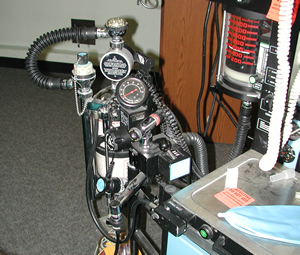Anesthesia Machine

Figure 1. Breathing circuit. |
A patient is admitted to the hospital for routine surgery, but before the procedure can even begin, serious complications arise with the patient’s breathing on the operating table. The doctors and nurses struggle to assess the situation. There is conflicting data from the monitors, and conflicting opinions from the staff about what to do. Twenty minutes pass until finally, the normally very reliable anesthesia machine that they had been using to breathe for the patient is abandoned, and he is resuscitated with a backup emergency device instead. Why was the medical staff so confused about his failed breathing, and did the equipment being used at the time contribute to this accident?
The patient was being administered oxygen through a face mask in preparation for the operation to begin. The face mask is attached through two flexible hoses to the breathing circuit on the anesthesia machine shown in Figure 1; one hose for the inhaled gases and the other for the exhaled gases. The breathing circuit is a loop consisting of hoses, two one-way valves, a carbon dioxide scrubber, and an accumulator bag – the exhaled gas is scrubbed of carbon dioxide and then re-inhaled; as oxygen is depleted from the circuit, fresh oxygen is automatically introduced. The pressure in the loop is controlled by an adjustable pressure limiting valve that automatically exhausts excess gas to the atmosphere.
The oxygen levels in the patient began to drop. The staff attempted ventilation by hand, squeezing the accumulator bag forcing oxygen into the patient’s lungs. What they did not know was that the patient could not exhale through the breathing circuit. The adjustable pressure limiting valve was stuck; even worse was that the valve would intermittently open confounding efforts to troubleshoot the problem. Even after the accident, on two separate occasions, investigators failed to notice the sticking valve. Not until our own examination and testing more than two years after the incident, our independent review of the two investigative reports, plus careful examination of video taken during the testing of the machine immediately after the accident, did we discover the root cause – a sticky substance had contaminated the adjustable pressure limiter valve and prevented its proper operation. The valve was removed and the sticky substance analyzed, but its source was never found – likely contamination left over from a previous operation.
